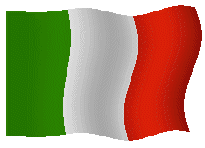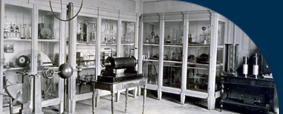 |
Brewster's stereoscope |
 |
Stereoscopio di Brewster |
| Subject: physiological optics/perception of relief in binocular vision |
Settore: ottica fisiologica/stereoscopia |
| Number of catalogue: 302 |
Numero di inventario: 302 |
| Unsigned, probably French |
Non firmato, prob. francese |
| 4/4 of the 19th century |
Periodo di costruzione: 2/2 del XIX secolo |
| Mahogany, brass, glass, iron, plastics |
Materiali utilizzati: Mogano, ottone, vetro, ferro, plastica |
| 185 X 160 X 105 [mm] |
Dimensioni: 185 X 160 X 105 [mm] |
| |
|
The principle underlying the functioning of this optical device is derived from the study of the physiology of vision (1830) by the English physicist Charles Wheatstone (1782-1875). The first specific publication concerning the device (reflecting type) appeared in 1838 but the invention probably dates back to the period between 1830 and 1832 because Wheatstone already had a prototype in 1832.This is a refraction stereoscope (with lenses) such as the one that was designed by the Scottish physicist David Brewster (1781-1868) in 1849. This model became very popular after the Great Exhibition in London in 1851, and during the 19th century its sales were second only to those of the kaleidoscope. Its name comes from two Greek words that mean "to see the relief or to have a three dimensional perception". This, therefore, allows for the perception of relief from the enlarged binocular vision of a pair of bidimensional images in the retina (drawings, pictures, etc.), which reproduce the same subject but appear slightly different. |
Il principio di funzionamento di questo apparato ottico scaturì da un contributo allo studio della fisiologia della visione (1830) da parte del fisico inglese Charles Wheatstone (1782-1875). La prima specifica pubblicazione sull'apparato (del tipo a riflessione) è del 1838 ma l'invenzione può essere retrodatata ad un periodo compreso tra il 1830 e il 1832 poiché Wheatstone già ne possedeva un prototipo nel 1832. Il presente stereoscopio è a rifrazione (lenticolare), del tipo progettato dal fisico scozzese David Brewster (1781-1868) nel 1849. Questo modello divenne molto popolare dopo la Great Exhibition londinese del 1851 ed ebbe, per tutto l'ottocento, un successo di vendite inferiori al solo caleidoscopio. Il suo nome deriva da due parole greche che significano veder solido, o a tre dimensioni. Esso, quindi, permette di ottenere la sensazione del rilievo dalla visione binoculare ingrandita di una coppia di immagini retiniche bidimensionali (disegni, fotografie ecc.), raffiguranti lo stesso soggetto, ma di aspetto leggermente diverso tra loro.
|
| |
|
Description: The instrument's frame is a trapezoidal-shaped mahogany box, which has two converging lenses and a sheet of frosted glass on the opposite side of the lenses (which acts as a diffusor of light) with two lateral openings for the introduction of stereoscopic cardboards. Internally the box is darkened and is divided into two parts by a piece of metal that prevents each eye from perceiving the image of the other. The focus setting of the separate steoroscopic vision is adjusted with a plastic washer that controls a rack and pinion mechanism. This mechanism moves the lenses, which are fixed in brass frames. A small mobile lid is fixed to the surface of the box with a hinge, and it is internally coated with a mirror for the frontal illumination of the stereoscopic views. |
Descrizione: il telaio dell'apparecchio è una scatola in mogano di forma trapezoidale, dotata di due lenti convergenti e sul lato opposto di una lastra di vetro smerigliato (che funge da diffusore di luce) con due fenditure laterali per l'introduzione dei cartoni stereoscopici. Internamente la scatola è annerita e divisa in due parti da un tramezzo metallico che impedisce a ciascun occhio la visione dell'immagine appartenente all'altro. La messa a fuoco della visione stereoscopica distinta viene regolata tramite una rondella di plastica la quale comanda un meccanismo a cremagliera che muove le lenti oculari, fissate in ghiere d'ottone. Sulla superficie della scatola è fissato a cerniera un coperchietto mobile rivestito internamente con uno specchio per l'illuminazione frontale delle vedute stereoscopiche. |
| |
|
Function: The stereoscopic cardboard is inserted in the vertical slots of the instrument. The cardboard is generally made up of a pair of designs or photographs that are glued to it. The pair of drawings or pictures are of the same subject, but they are reproduced from slightly different angles. Each eye transmits the two slightly different two-dimensional images to the brain, which blends the images, thus creating the perception of a three-dimensional scene. This instrument is provided with a stereoscopic cardboard that shows a pair of pictures of a Swiss winter landscape. |
Funzionamento: si inserisce il cartone stereoscopico lungo le apposite fenditure dell'apparecchio. Esso è generalmente costituito da una coppia di disegni o fotografie del medesimo soggetto, appena sfasate tra loro, e incollate l'una accanto all'altra. Ciascun occhio fornisce quindi al cervello due immagini bidimensionali leggermente diverse che, venendo fuse, creano la percezione della profondità della scena Il cartone stereoscopico di cui è corredato il pezzo è una coppia di fotografie che ritrae uno scorcio invernale svizzero. |
| |
|
Bibliography: Wheatstone [1830], pp. 101-117; Idem [1831], pp. 534-537; Idem [1838], pp. 16-17; Brewster [1849], pp. 6-7; Persico [1932], pp. 269-272. |
Bibliografia: Wheatstone [1830], pp. 101-117; Idem [1831], pp. 534-537; Idem [1838], pp. 16-17; Brewster [1849], pp. 6-7; Persico [1932], pp. 269-272. |

